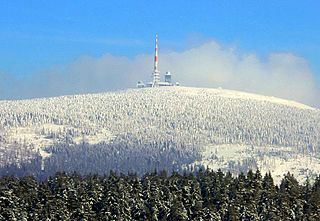
The Brocken, also sometimes referred to as the Blocksberg, is the highest peak in the Harz mountain range and also the highest peak in Northern Germany; it is near Schierke in the German state of Saxony-Anhalt between the rivers Weser and Elbe. Although its elevation of 1,141 metres (3,743 ft) is below alpine dimensions, its microclimate resembles that of mountains of about 2,000 m (6,600 ft). The peak above the tree line tends to have a snow cover from September to May, and mists and fogs shroud it up to 300 days of the year. The mean annual temperature is only 2.9 °C (37.2 °F). It is the easternmost mountain in northern Germany; travelling east in a straight line, the next prominent elevation would be in the Ural Mountains in Russia.

The Selke Valley Railway (Selketalbahn), Gernrode-Harzgerode Railway and the Anhalt Harz Railway were different names for the metre gauge railway in the Lower Harz, Germany, originally owned by the Gernrode-Harzgerode Railway Company.
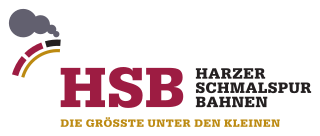
The Harz Narrow Gauge Railways is a railway company that operates a 1,000 mmmetre gauge network in the Harz mountains, in central Germany. The company was formed after the Second World War as a merger of two earlier companies. It owns about 140 kilometres of track, connecting the principal towns of Wernigerode, Nordhausen and Quedlinburg and several smaller settlements in the area. Much of the network is steeply graded and picturesque, but its most popular destination is the Brocken, the highest mountain in the region. The company runs a significant number of its trains with steam haulage, mostly employing 1950s vintage 2-10-2 tank locomotives, hauling traditional open-platform bogie carriages. The company is mainly owned by the various local authorities whose territories it serves.

Elbingerode is an Ortsteil of Oberharz am Brocken in the Harz district, in the German state of Saxony-Anhalt. The former town was incorporated into the newly established municipality on 1 January 2010.

Schierke is a village and a former municipality in the Harz district, in the German state of Saxony-Anhalt. Since 1 July 2009, it is part of the town Wernigerode. Situated within the Harz mountain range in the valley of the river Bode, at the rim of the Harz National Park, it is mainly a tourist resort, especially for hiking and all kinds of winter sports.
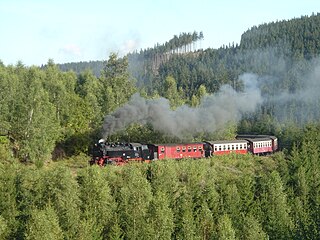
The Harz Railway or Trans-Harz Railway was formerly the main line of the Harz Narrow Gauge Railways and runs north to south right across the Harz Mountains from Wernigerode to Nordhausen. However, the tourist attraction of the Brocken, the highest mountain in the Harz, is so great that the Brocken Railway is effectively the main line today. The Trans-Harz Railway joins up with the Selke Valley Railway to Quedlinburg at Eisfelder Talmühle where all trains are organised to make good connections.

The three engines of DRG Class 99.22 were standard, narrow gauge locomotives (Einheitsloks) in service with the German Reichsbahn. They had operating numbers 99 221 to 99 223.
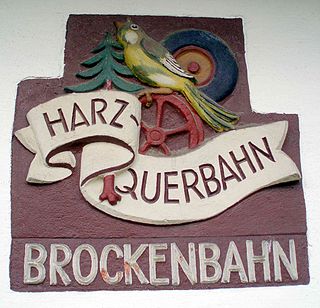
The Nordhausen-Wernigerode Railway Company or NWE was the second railway company to be founded in the Harz mountains in Germany, after the Gernrode-Harzgerode Railway Company. On 15 June 1896 the NWE was formed by the Vereinigten Eisenbahnbau- und Betriebs-Gesellschaft in Berlin, who also ran its operations. As early as 1896 the first section of this narrow gauge Harz Railway ('Harzquerbahn') was opened, followed in 1898 by the Brocken Railway (Brockenbahn), which was also narrow gauge. On 1 April 1908, the NWE took over operations from the Vereinigten Eisenbahnbau- und Betriebsgesellschaft.

The Hohnekamm or Hohne Kamm is a mountain ridge up to 900 m above sea level high in the Harz mountains of central Germany. It is located in the state of Saxony-Anhalt, and is well known for its rock towers or tors, the Hohneklippen.
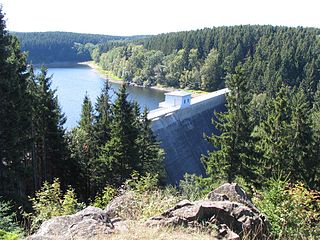
The Zillierbach Dam lies in the East Harz in the German state of Saxony-Anhalt near the town of Elbingerode (Harz) and impounds the Zillierbach stream. It supplies drinking water to several villages in the High Harz as well as the town of Wernigerode; it also provides flood protection.
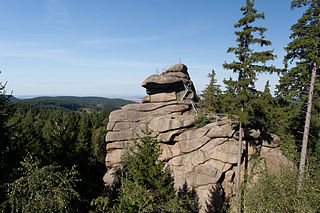
The Ottofels, named after Prince Otto of Stolberg-Wernigerode, is a tor and natural monument near Wernigerode in the Harz mountains of central Germany.

Drei Annen Hohne is the name of a small settlement within the municipal area of Wernigerode in Saxony-Anhalt, Germany.
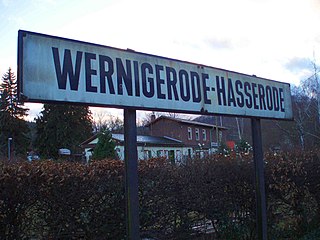
Hasserode has been a quarter in the town of Wernigerode in the German state of Saxony-Anhalt since 1907.

The Trudenstein is a rock formation and popular hiker's destination in the Harz Mountains of central Germany. It is located in the federal state of Saxony-Anhalt.
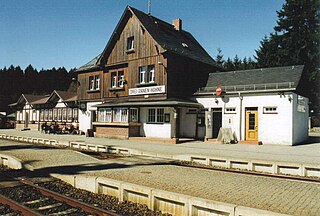
Drei Annen Hohne station is a branch-off station on the Harz Railway and the Brocken Railway.

Schierke station is the railway station in the village of Schierke operated by the Harz Narrow Gauge Railways on the Brocken Railway in the Harz Mountains of central Germany. Schierke itself lies as the foot of the highest mountain in the Harz, the Brocken, and is located in the borough of Wernigerode in the federal state of Saxony-Anhalt.

The Nordhausen-Wernigerode Railway Company incorporated twelve Mallet locomotives into its fleet as Numbers 11 to 22. In 1950 the remaining locomotives were renumbered as Class 99.590 by the Deutsche Reichsbahn.

The NWE No. 21II, later DR 99 6001 is a narrow gauge steam locomotive that was built in 1939 for a track gauge of one metre and is still on duty with the Harz Narrow Gauge Railways (HSB) today.
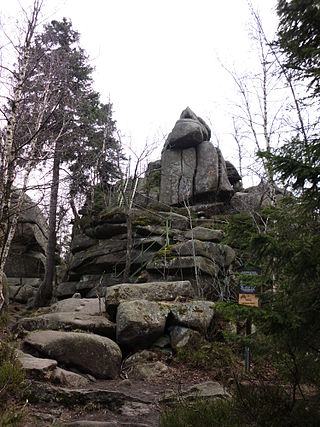
The Ahrensklint or Ahrentsklint in the Harz Mountains is a granite rock formation, 822.4 m above sea level (NN), on the Erdbeerkopf in Harz district in the German state of Saxony-Anhalt.
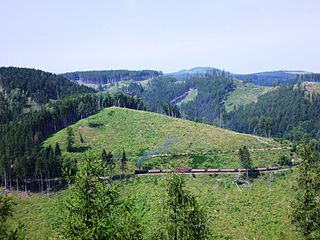
The Elversstein in the Harz Mountains of Germany is a granite rock formation with a maximum elevation of 499 m above sea level (NN) on the Steinberg near Hasserode in the county of Harz in Saxony-Anhalt.































